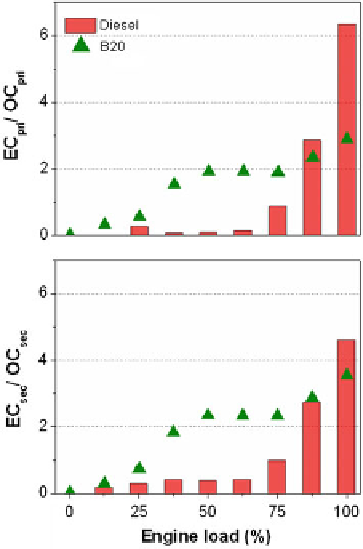Environmental Engineering Reference
In-Depth Information
6.2 Chemical Characterization of Particulates
Higher particle number concentration for secondary emissions (Fig.
5
) and corre-
spondingly higher particulate surface area (Fig.
6
) was seen with increasing engine
load. The surface area distribution in secondary emissions from B20 was lower by
an order of magnitude as compared to mineral diesel. Enhanced surface area of
particles corresponds to more number of sites readily being available for the con-
densation of toxic organic species (Br
ü
ske et al.
2010
). Hence, secondary emissions
from diesel have relatively larger toxic potential as compared to B20.
Increase in EC upon increasing engine load has also been recorded in past
studies (Gupta et al.
2011
). Fuel-to-air ratios were relatively higher at higher engine
loads leading to higher EC formation. Lubricating oil pyrolysis at relatively higher
temperatures actually results in even higher EC measured at higher engine loads
(Sharma et al.
2005
). OC increased with an increase in engine load and attained a
maxima and then it decreased with further increase in the engine load (Gupta et al.
2011
). Higher oxygen content of B20 facilitated more ef
cient combustion as
compared to the mineral diesel (Fig.
7
). EC/ OC ratio was observed to be higher for
diesel at higher engine loads. Whereas, for B20 it was relatively lower as compared
to mineral diesel at higher engine loads.
At 1,800 rpm, the total particle bound PAHs were found to increase with higher
engine loads (Fig.
8
) for both the fuels. For both the fuels, PAHs in secondary
Fig. 7 Variation of EC/OC
ratio for primary and
secondary versus engine load
for primary and secondary
exhaust fuelled with diesel
and B20 (adapted from
Agarwal et al.
2013
)

Search WWH ::

Custom Search